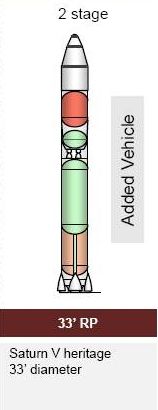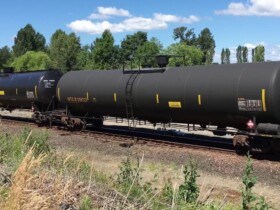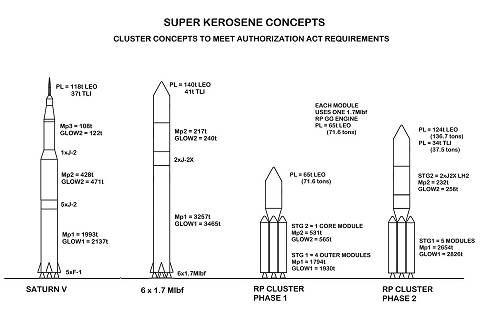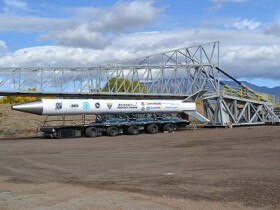Concept 103
The Congressional “NASA Authorization Act of 2010” directed NASA to build a new Shuttle-Derived (SD) “Space Launch System” (SLS). The Act called for SLS to be developed in two phases. Phase One would be able to lift 70-100 tons (63.5 to 90.7 metric tons or tonnes) to low Earth orbit (LEO). Phase Two would include improvements designed to increase LEO payload to at least 130 tons (118 tonnes).
NASA has studied a number of “in-line” SLS concepts that would use a pair of four or five-segment solid rocket boosters to lift a core powered by three to five RS-25 engines derived from the existing Space Shuttle Main Engine (SSME). A “5/5” design with five RS-25s and a pair of five-segment boosters was tagged as the preferred option, but NASA Administrator Bolden told Congress that, given expected budget conditions, NASA could not afford to develop the rocket.

A new option, largely non-Shuttle-Derived, appeared during the 2010 trade studies. It used a large kerosene fueled first stage and a liquid hydrogen second stage. The first stage would be powered by new high-thrust engines. NASA’s planned J-2X engine would power the second stage. The new 10 meter-diameter rocket, identified as “Concept 103” in the trades, looked and acted, in general terms, like a scaled-up Atlas 5.
Elon Musk’s SpaceX Corporation proposed a similar design, called “Falcon XX”, while the trade studies were underway. Whether Falcon XX was the trigger, for Concept 103, or a response to it, is not known. Falcon XX, a 10 meter diameter two-stage rocket that would stand nearly as tall as a Saturn 5, would be powered by six “Merlin 2” engines, producing a total of 10.2 million pounds of thrust off the pad.
Each Merlin 2 would produce 1.7 million pounds thrust at sea level and 1.92 million pounds thrust in vacuum. The company discussed plans for a “Raptor” liquid hydrogen engine for the upper stage, but these plans were not detailed. Falcon XX would lift 140 tonnes to low earth orbit (LEO).
SpaceX claimed that Merlin 2 could be qualified in three years for $1 billion. The claim appears remarkable, to say the least, given the nearly decade long development effort required for Rocketdyne’s Saturn V F-1 engine.
Also read:
Super-Kerosene

Concept 103, and presumably Falcon XX, looks like a clever design compared to Shuttle-Derived options. The super-kerosene rocket can do essentially what Saturn V did, but with two stages rather than three. The second stage is smaller than might be expected – and uses fewer engines than, for example, the S-II stage, but that allows it to serve not just as an ascent stage, but also as an Earth Departure Stage. The rocket can, as a result, lift either 140 tonnes to LEO or 40-45 tonnes to escape velocity. The advanced kerosene first stage, with its inherently high propellant mass fraction and modernized, improved-efficiency engines, helps makes this possible.
In contrast, any Shuttle-Derived concept needs four propulsion stages for escape velocity (2 SRBs, one Core, and one Departure Stage). That is why Concept 103 was projected to cost substantially less than, for example, “5/5”, to operate.
Since it would weigh much less than an SD design at rollout, an all-liquid rocket would be able to use existing launch infrastructure at Launch Complex 39. The heavier SD designs require new crawler-transporters, launch platforms, and a rebuilt crawlerway, for example.
Concept 103 design details have not been provided, but it is possible to model potential designs.
Three conceptual kerosene boosted two-stage designs that lift at least 130 “tons” (118 tonnes) to LEO are shown in the adjacent figure. All have 1.2 liftoff thrust to weight ratios, and 0.7 thrust to weight ratios at Stage 2 start. All second stages have Ares 1 Upper Stage propellant mass fraction (PMF) of 0.905.
Design 1 uses six F-1 engines, resurrected somehow from the rocket graveyard, or redeveloped, to power the first stage and two J-2X engines for the second. The first stage PMF is 0.94. First and second stage gross weights are 3,060 and 260 tonnes, respectively. LEO payload = 132 tons (120 tonnes). Escape payload = 37 tons (34 tonnes).
Design 2 uses six Merlin 2 type engines of 1.7 Mlbf each on Stage 1 and 2 J-2X engines on Stage 2. PMF are the same as Design 1. Stage gross weights are 3,465 and 240 tonnes. LEO payload = 154 tons (140 tonnes). Escape payload = 45 tons (41 tonnes).
Design 3 uses ten RD-180 engines on Stage 1 (PMF=0.93) and two J-2X on Stage 2. Stage gross weights are 2,860 and 250 tonnes. LEO payload = 143 tons (130 tonnes). Escape payload = 42 tons (38 tonnes).
The figure shows the concepts alongside Saturn V, scaled to approximate height. Dimensions are shown assuming no shared tank bulkheads on either stage. If a common bulkhead were introduced, it would reduce the overall height of a vehicle by about 10 meters, or one tank diameter.
Although the rockets, at first glance, appear to be very tall, they actually stand no taller than NASA’s preferred “5/5” SLS reference design, and only slightly taller than the Ares I-X that flew in 2010. The first stages of each concept are substantially longer than any Saturn stage, but are roughly comparable to the length of the “5/5” core stage.
Trimming down to a single J-2X engine on the second stage would substantially reduce LEO payload, perhaps by 20-25%, but even then only if the Atlas 402 second stage thrust-to-weight ratio of 0.57 is allowed. The latter assumption requires use of the Atlas lofted trajectory. A single-J-2X makes less difference for a TLI payload, only reducing that performance by about 10%.
An important trade would be between staged-combustion and gas-generator cycle first stage engines. Staged-combustion engines would cost more, but deliver more performance. Gas-generator engines would cost less and be more reliable. With Merlin 2, SpaceX has proposed a way to close the performance gap while maintaining the cost advantages of the gas-generator engine.
Merlin 2 would operate at higher pressure than Saturn V’s F-1 engine, resulting in higher specific impulse. The engine would also take advantage of materials improvements to reduce engine weight. Gas generator cycle Merlin 2 average specific impulse during a first stage burn could reach or exceed 300 seconds, a substantial improvement from previous kerosene gas-generator engines.
The following model, for example, assumes use of staged-combustion first stage engines roughly as efficient as the Atlas 5 RD-180. Six 1.7 million pound (771 tonne) thrust engines power the first stage. Two J-2X engines power the second stage. The rocket can lift either 149 tonnes (329,367 lbs) to LEO or 45 tonnes direct to escape velocity.
Stage 1:
Gross Mass: 3,096 tonnes
Usable Propellant: 2,879 tonnes
Liftoff Thrust 4,218 tonnesf
T/W = 1.2
Stage 2:
Gross Mass: 260 tonnes
Usable Propellant: 234 tonnes
Thrust 266 tonnesf
T/W = 0.65
Fairing: 10 tonnes
Payload: 149.4 tonnes
Delta-v = 9,237 m/s
If Payload = 45 tonnes
Delta-v = 12,398 m/s
It is possible to contemplate a variety of scaled super-kerosene designs using Merlin 2 type engines. Consider, for example, the following.
A 3×1.7Mlbf first stage topped by a 1xJ2X second stage can lift 70 tonnes to LEO or 20 tonnes to escape.
A 4×1.7Mlbf first stage with a 1xJ2X second stage lifts 80 tonnes to LEO or 23.5 tonnes to escape.
A 5×1.7Mlbf first stage with a 2xJ2X second stage can haul 125 tonnes to LEO or 35 tonnes to escape.
Authorization Act Limitations

The NASA Authorization Act imposes a number of restrictions that may or may not survive as the SLS program proceeds. The Act calls for an initial design capable of lifting 70-100 tons (63.5 to 90.7 metric tons or tonnes) to low Earth orbit (LEO). A subsequent design would include improvements designed to increase LEO payload to at least 130 tons (118 tonnes). The addition of an upper stage was listed as a specific improvement.
It is possible, though suboptimal, to design a phased “super kerosene” implementation that roughly meets the Authorization Act requirements. The adjacent figure shows one approach, shown in comparison to Saturn V and the previously-discussed “Falcon XX”-like design.
“Phase One” would lift 71.6 tons (65 tonnes) to LEO using five nearly identical kerosene/LOX modules, each powered by a 1.7Mlbf GG engine. Each module would be roughly the same size as a Delta IV CBC. For Phase One, only the outer four modules would ignite on the pad to serve as a first stage.
The center module would air-ignite to serve as a throttled-down second stage. 82 tonnes of propellant would be offloaded from each of the outer four modules, but the center module would carry a full 531 tonne propellant load.
An upper stage would be added to create “Phase Two”. This rocket would fire all five modules – all fully loaded with propellant this time – off the pad to serve as a first stage. Two J-2X engines would power the new upper stage. The rocket would lift 124 tonnes (136.7 tons) to LEO or 34 tonnes (37.5 tons) to escape velocity.
Author:
by Ed Kyle, 03/21/2011
















Got a Questions?
Find us on Socials or Contact us and we’ll get back to you as soon as possible.